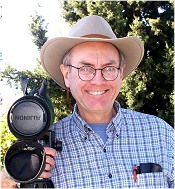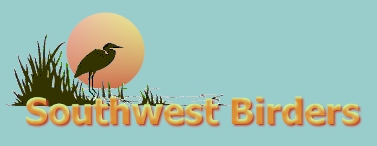Southwest
Birders is a partnership of birdwatchers who love the sport and would
like to introduce you to the joys of birding in the Imperial and Lower
Colorado River Valleys, Orange County, Southern Arizona, and coastal Southern California. We know the area well and want to assist you
in finding any birds that reside here. We'll be happy to e-mail you
information about rare and common birds, or accompany you on tours of the
area. Write or call us if we can help in any way!
Birding
Guide - Henry Detwiler
I started birding in grade school one snowy day when my parents bought a
birdseed bell for our back
yard in Carbondale, Illinois. Beautiful
cardinals, chickadees, and titmice soon arrived to feast on the new-found
bounty, so we bought a Peterson's field guide to ID them. I was
hooked. That spring I ventured out on my bicycle in the surrounding
farmland and woods to discover wonderful feathered creatures like the
Eastern Meadowlark, the Field Sparrow, and the striking Scarlet Tanager.
My first overnight field trip was a few years later when I rode along with
some college students to the plains of central Illinois to camp out in a
barn. We arose at 4:00 a.m. the next morning and entered our
blinds. As dawn broke, Greater Prairie Chickens emerged from the
fields and started booming and dancing for us.
|

|
The
Air Force took me to Oklahoma, where I got my first real taste of the
West, and was treated to spectacular birds like the Scissor-tailed
Flycatcher and Golden Eagle. A couple of years in the San Francisco
area allowed me to experience the towering redwoods and the Pacific
Ocean. Rarities were a way of life, and on one day I chased and
located a Brambling and a White-tailed Wagtail in the same afternoon. In
1990 I moved to Yuma, half-way between San Diego, CA, and Phoenix, AZ. My
stomping grounds now include two of the hottest birding locales in the
U.S., the Salton Sea and Southeastern Arizona.
Over
the years I have served as President of the Southern Illinois Audubon
Society, member of the Arizona Rare Bird Committee, written bird-finding
articles for "Winging It" and "Birder's World", participated in the AZ
Breeding Bird Survey, assisted with 30
years' worth of spring and Christmas bird counts, given presentations on
birds & birding to Audubon and Elderhostel groups, and led bird tours
for the Salton Sea Birding Festival and local clubs. I've had the
good fortune to watch birds in almost every state and twenty-one
countries. What a great hobby!
-
Behaviors & Field
Marks
- Distribution:
Nests in Yuma, but ranges far and wide throughout the year
- Migratory
Patterns: Permanent resident, but every May can be found
visiting parents (and birds) in Illinois
- Size: length 67", wingspan
one to two arms' lengths, hat size 7¼"
- Calls:
"Pish, pish" "hoo, hoo, hoo" "Here birdie,
birdie"
- Song: A
singularly unmelodic jumble of notes usually heard around
Christmas time
- Habits:
Often observed chasing small birds, but does not appear to eat
them
Phone me at 928-247-3098
(cell) or
send e-mail to HenryDetwiler@earthlink.net
|
Birding
Guide - Bob Miller
I was born and raised in the Imperial Valley, where the sun spends the winter, and I still hang my many different hats here. I am a deputy with the Imperial County Sheriff’s Mounted Posse and
a past Caller for a ladies equestrian drill team called The Galloping Gossips. The Gossips
were formed in 1956 in Brawley. They square dance on horseback, performing all over the
Southwest and have ridden in the New Years Day Tournament of Roses
Parade 13 times.. They are currently innactive. |
 |
I grew up exploring the local deserts, lakes, mountains, and fields. I knew the animals, plants, bugs,
and thought I had a pretty good handle on the birds, till a good friend gave me a birding field guide. WOW! Suddenly there weren't just a few kinds of sparrows, there were dozens, and those dozens had dozens of sub-species. I was hooked.
Not knowing a single other person who was a birdwatcher, or even knowing there were
RBA’s, the ABA, or an Audubon Society, I spent years birding on my own. I nearly wore my "Golden" field guide out. Soon I was running around with an entire library in the back seat of my pickup. Then the Salton Sea International Bird Festival came along, and I discovered lots of other people were into this birdwatching thing. WOW again!
I was a professional truck driver for 22 years. A near fatal accident in January ‘98
left me unable to continue trucking and was a real attitude adjuster for me. We’ve all heard that the road to true happiness is
finding what you love to do and doing that for a living, so I’ve been birding non-stop ever since.
Well, sort of non-stop! Working with computers is fun too and my dad was a
carpenter so I learned quite a bit about construction as well.
Learned AutoCAD and graphics animation through Imperial Valley Regional
Occupation Program which is exciting stuff to me. Hired on as an
architectural draftsman with a local Architect, Sanders Inc, and have now
worked on modernizing or new construction at just about every school in
Imperial Valley and a few brand new ones as well! Did love truckin, no
doubt, but am happier in the wild beside the road than looking out the
window at that wild! Have been involved with the Salton Sea International Bird
Festival gathering guides and speakers and leading field trips ever since.
Lead many field trips for numerous Audubon groups and the San Diego Natural History
Museum. Have been involved with many bird counts and several bird banding
projects. Have been walking about 250 miles a year through the Algodones
Dunes Wilderness Area of the Imperial Sand Dunes for an ongoing point
count bird survey that I do every December and April.
I can’t take you to the jungles of South America, but I sure can show you around my own backyard, the Southwestern desert, and introduce you to the wildlife I love and share it with.
- Behaviors & Field
Marks
-
Distribution: Indigenous to the Desert Southwest.
-
Migratory
pattern: Takes flight in late evening and flies at freeway speeds to Southeast Arizona or coastal California at every possible chance. Usually brought on by extreme summer temperatures or the monsoon season.
-
Size: Height- 76", Weight--average for this height (well, maybe a little over in the flanks) Extremely long-legged land bird.
-
Description: Large beak noticeably broken to the right side, very large western moustache with matching clothing and well-worn hat. Eyes, blue and in bifocal denial. Hearing, not what it used to be. Like most desert dwelling species has an extreme fondness for rain and water.
-
Calls: Upon starting out on field trips is heard to call "Jingle them spurs an’ jerk them cinches
folks, we’ve a bird to be seen!!" Also can be heard calling square dance at rodeos and equestrian events.
-
Song: Can’t, but does anyway.
-
Habits: Of course.
Phone me at 760-455-1413 or
send e-mail to bob.miller@mindspring.com
Birding
Guide - Bruce A. Aird
 I am a 40-something laboratory biochemist by trade, working as a Senior Scientist for a specialty
pharmaceutical company in Irvine, CA. I've been birding since 1981, but I've been a nature lover and
conservationist all my life. I've visited all the lower 48 states (have lived in 5 of them) and all but 4 of the Canadian provinces, and have made a few forays into Mexico for birds as well. I more or less came of
age as a birder when I lived and birded in Texas for 4 years, where I got involved with avian censusing, working with the Texas Parks & Wildlife Department and several private ecological contractors to count Black-capped Vireos and Golden-cheeked Warblers in the Hill Country. I have been doing 2-3 CBC's per year since 1987, and have collected over 5 years of neotropical migrant survey data at a site in Orange County, as part of National Audubon’s Partners-in-Flight program. I believe a bad day
of birding beats a good day of doing pretty much anything else. I am a 40-something laboratory biochemist by trade, working as a Senior Scientist for a specialty
pharmaceutical company in Irvine, CA. I've been birding since 1981, but I've been a nature lover and
conservationist all my life. I've visited all the lower 48 states (have lived in 5 of them) and all but 4 of the Canadian provinces, and have made a few forays into Mexico for birds as well. I more or less came of
age as a birder when I lived and birded in Texas for 4 years, where I got involved with avian censusing, working with the Texas Parks & Wildlife Department and several private ecological contractors to count Black-capped Vireos and Golden-cheeked Warblers in the Hill Country. I have been doing 2-3 CBC's per year since 1987, and have collected over 5 years of neotropical migrant survey data at a site in Orange County, as part of National Audubon’s Partners-in-Flight program. I believe a bad day
of birding beats a good day of doing pretty much anything else.
I've lived and birded in Orange County since mid-1994, and am active with the Sea & Sage Audubon chapter. I have run their Birdathon funding event, which has placed as high as 2nd in the nation out of more than 200 participating Audubon chapters. I've been a field trip leader in some capacity since 1989, and I've been a guide at every Salton Sea International Bird Festival thus far. I also lead 2-3 trips per year for Sea & Sage Audubon and the CA Nature Conservancy. I've given a number of nature slide/lecture talks, some consisting entirely of my own photos (which tend to be longer on enthusiasm than skill).
-
Behaviors & Field Marks:
-
Distribution:
Resident
legal alien in Lake Forest, CA, given to extended forays to local hot spots
-
Reproductive Status:
Monogamous (for about 18 years); both genders assist in raising young (big job!)
-
Average Brood:
Typically two highly precocial young (though these data are based on a limited sampling)
-
Physical Attributes:
A medium-sized species (~69") usually observed in highly worn plumage that suggests inept preening, beak large, eyes blue, feet booted, cap wide-brimmed, stained with age, often erected in wind
-
Calls:
Highly variable from excited yelps (good bird!) to unprintable (good bird just missed!)
-
Song:
Ceased to be heard in the field when it was discovered to actually lower the chance of breeding success
-
Habits:
Used to be vices; periods of peak activity: crepuscular; lives to bird
Phone me at
(949) 788-5344 during the day or
send e-mail to baaird@earthlink.net
Birding
Guide - Vic Leipzig
 |
I became hooked on birding in 1976 when I was a graduate student. A mute swan swooped off the Connecticut River and flew straight at me, swooshing mere feet over my head. I ducked and shouted "What the hell was that?" I've been asking myself that about birds ever since.
Birding grew from a pastime to a passion, and I am now a professional birder. I have an undergraduate degree in political science from Stanford University and a doctorate in biology from Wesleyan University. I teach biology at several southern California colleges, including a popular "birding for seniors" class that is offered by Saddleback and Irvine Valley Colleges. |
Although most of my time is spent teaching and birding, I found time to serve on the Planning Commission in Huntington Beach, CA for 6 years, the City Council for 4 years, and was Mayor in 1995. I'm active in many conservation organizations and wetlands restoration groups and have served on the board of directors of Sea and Sage Audubon, the Amigos de Bolsa Chica, the Bolsa Chica Conservancy, and the Huntington Wetlands Conservancy, among others. I am dedicated to saving and restoring California's coastal wetlands.
I have a weekly newspaper column devoted to environmental issues, and have published birding and wetlands conservation articles in WildBird and other magazines. I've led field trips for Audubon, Sierra Club and other conservation groups, the Salton Sea International Birding Festival, and many international visitors. I'd love to show you some of my favorite local birding hot spots.
-
Behaviors & Field Marks:
-
Distribution:
Wide distribution, frequent migrations, resident of Huntington Beach, CA; seen widely throughout coastal, mountain, and desert regions of Orange, Riverside, San Diego, San Bernadino, and Imperial
Counties
-
Reproductive Status:
Mated for life to Louann Murray, PhD, a writer, photographer, and birder; courts throughout the year; two offspring, both fledged
-
Physical
Description: A lean, lanky species with thin legs, long wings, and sparse feathering. Buff rump is rarely seen
-
Calls:
Yes, accepts calls as long as they aren't collect
-
Song:
A quiet species, sings only when bathing
-
Habits:
Loves to lecture other members of the species; no bad habits except for compulsive birding
Phone me at
(714) 848-5394 or
send e-mail to vicleipzig@aol.com
| 



 I
I